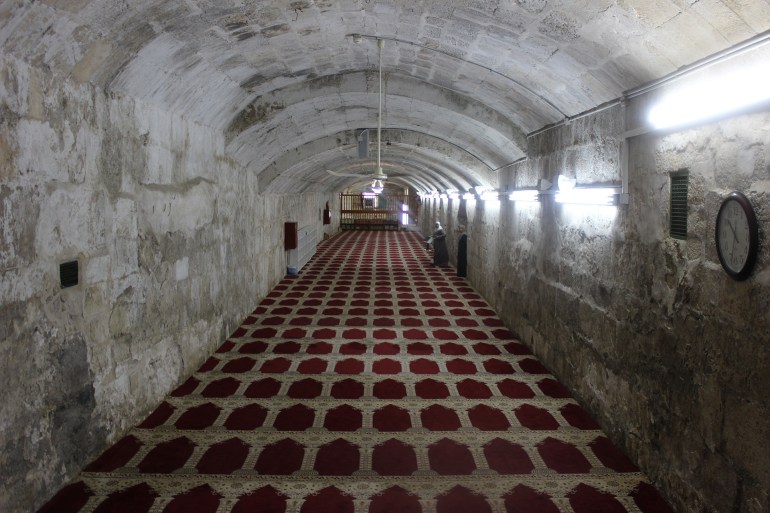Occupied Jerusalem
- For the second time in 4 years, a stone from the southern wall of the blessed Al-Aqsa Mosque fell, and this time the stone fell inside the old Al-Aqsa Mosque, above the mihrab located between the Khatniyah School and the Oil Tank Room, at a point located almost below the mihrab of the Al-Qibli prayer hall.
The old Al-Aqsa Mosque is located below the central portico of the Al-Qibli prayer hall, extending longitudinally from north to south, and ending with a door known as "The Prophet's Gate".
The prayer hall consists of two porticos surrounded by huge stone columns, and the building was used as a corridor for the Umayyad caliphs, Faisal, to their palaces located behind the al-Qibli prayer hall.
A general picture from inside the old Al-Aqsa Mosque, inside which a huge stone fell from the southern wall (Al-Jazeera)
3 reasons
Prior to the stone fall incidents, cracks were evident in the structure of the southern side of the western wall of the mosque.
The researcher in Jerusalem affairs, Ziyad Abhis, attributed the stone fall to 3 reasons:
The structure of the Al-Aqsa Mosque:
its southern side is built over settlements extending from its western wall to its eastern wall. It was built in the Umayyad era, and the average height of its ceilings is 7 meters. They are stone settlements that are more than 1,300 years old today. And the Islamic Museum opposite it from the west side, and the women’s chapel adjacent to the wall from the south, which doubles the existing loads above these settlements and makes them in constant need of maintenance and strengthening.
Obstruction of restoration:
Since 2012, the occupation authorities have continued to prevent all restoration and maintenance works in the blessed Al-Aqsa Mosque, considering them actions that undermine “Israel’s sovereignty” over the mosque, with the exception of the completion of some previous projects.
The last restoration carried out by the Jordanian Islamic Endowment Department of the southern walls was carried out in 2004 after political pressures in the United Nations Educational, Scientific and Cultural Organization (UNESCO), and after the cracks were clear and expanding from 3 sides, namely:
Al-Khatniyah School in the South.
The triple door closed with stones.
The southern side of the eastern wall, which the endowments had to replace large sections of the stones at that time.
Occupation excavations:
specifically the excavation called “Pilgrims’ Road” and it aims to connect the excavations south of Al-Aqsa in Silwan with the western excavations adjacent to the western wall of Al-Aqsa. It opens the door for entry into that settlement from the excavations that surround it from two sides, which threatens to revive the first plans for dividing Al-Aqsa, considering the underground for the Jews and the above for the Muslims, which was proposed by Ehud Barak’s government in the Camp David negotiations in 2000 and Taba in 2001.
A picture of the huge stone pillars located inside the old Al-Aqsa Mosque, next to which the stone fell (Al-Jazeera)
western wall
In addition to these reasons, researcher Ibhis stressed the seriousness of the renewed construction problems facing the walls of Al-Aqsa Mosque from the south, and they are concentrated in the southern section of its western wall, which the occupation authorities usurped the powers to restore from the Jordanian endowments in January 2019 in a historical precedent that occurred in Al-Aqsa for the first time since its occupation, as well as the Southern Wall at its midpoint.
The greatest danger, according to the Palestinian researcher, now includes the southwestern settlement that lies between the Qibli Mosque and the Mughrabi Gate. It is an Umayyad settlement of similar origin to the Marwani mosque, but it is divided into rooms because they were used as wells for storing water.
This settlement has not been restored for decades, and pressures have increased on its outer walls due to the dumping of dust carried out by the occupation authorities in the past two decades, in the south and west, as they removed dust with a height of more than 5 meters that was supporting these walls, and this puts this settlement today in front of real dangers.
A picture showing the antiquity and age of the old Al-Aqsa Mosque building and its need for continuous restoration (Al-Jazeera)
jewish city
Abhis concluded his speech to Al-Jazeera Net by saying that the occupation has been working for many years to this day to build a Jewish city that simulates the biblical description of the alleged "Jewish Jerusalem" in the vicinity of the Old City of Jerusalem and in the vicinity of Al-Aqsa and below.
Until the end of 2016, there were about 63 excavations under and around the mosque, and the occupation authorities justified the excavations under the pretext of searching for “Jewish antiquities” belonging to the alleged temple, but the goal of the excavations went beyond that, so that the network of tunnels and excavations became part of the historic “Jewish holy city.”

